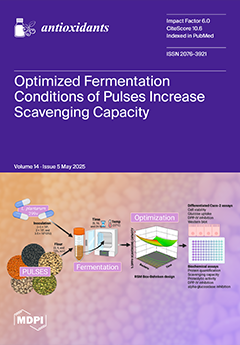This study examined branched-chain fatty acids (BCFAs)’ effects on oxidative stress, energy metabolism, inflammation, tight junction disruption, apoptosis, and Toll-like receptor 4/nuclear factor kappa-B (
TLR4/NF-κB) signaling in lipopolysaccharide (LPS)-induced calf small intestinal epithelial cells (CSIECs). Eight groups were used: a control
[...] Read more.
This study examined branched-chain fatty acids (BCFAs)’ effects on oxidative stress, energy metabolism, inflammation, tight junction disruption, apoptosis, and Toll-like receptor 4/nuclear factor kappa-B (
TLR4/NF-κB) signaling in lipopolysaccharide (LPS)-induced calf small intestinal epithelial cells (CSIECs). Eight groups were used: a control group, an LPS-induced group, and six BCFA treatment groups (12-methyltridecanoic acid (iso-C14:0), 13-methyltetradecanoic acid (iso-C15:0), 14-methylpentadecanoic acid (iso-C16:0), 15-methylhexadecanoic acid (iso-C17:0), 12-methyltetradecanoic acid (anteiso-C15:0), and 14-methylhexadecanoic acid (anteiso-C17:0)) with LPS. The BCFA pretreatments significantly increased CSIEC activity compared to the LPS-induced group, with iso-C14:0 showing the highest activity (89.73%). BCFA reduced Reactive Oxygen Species (ROS) generation and malondialdehyde (MDA) levels and improved the superoxide dismutase (SOD), glutathione peroxidase (GSH-Px), and catalase (CAT) activities and glutathione (GSH) levels. Iso-C16:0 optimized total antioxidant capacity (T-AOC). BCFA enhanced the mitochondrial membrane potential, Adenosine Triphosphate (ATP) enzyme activity, and ATP content, with iso-C14:0 increasing ATP by 27.01%. BCFA downregulated interleukin (
IL)
-1β,
IL-8, tumor necrosis factor (
TNF)-
α, and interferon (
INF)-
γ gene expression, reduced IL-6 levels, and increased
IL-10 expression. Myeloid differentiation factor 88 (
MyD88) mRNA levels were reduced. BCFA alleviated Zonula Occludin (
ZO-1),
Claudin-1, and
Claudin-4 decrease and increased Occludin levels. BCFA mitigated LPS-induced increases in
Caspase-3 and BCL2-Associated X (
BAX) mRNA levels, reduced
Caspase-8 and
Caspase-9 expression, and increased B-Cell Lymphoma-2 (
BCL-2) mRNA levels. The Entropy Weight-TOPSIS method was adopted, and it was discovered that iso-C15:0 has the best effect. In summary, BCFA supplementation mitigated oxidative stress and enhanced mitochondrial function. BCFA inhibited
TLR4/NF-κB signaling pathway overactivation, regulated inflammatory cytokine gene expression, reduced cellular apoptosis, preserved tight junction integrity, and supported barrier function.
Full article






